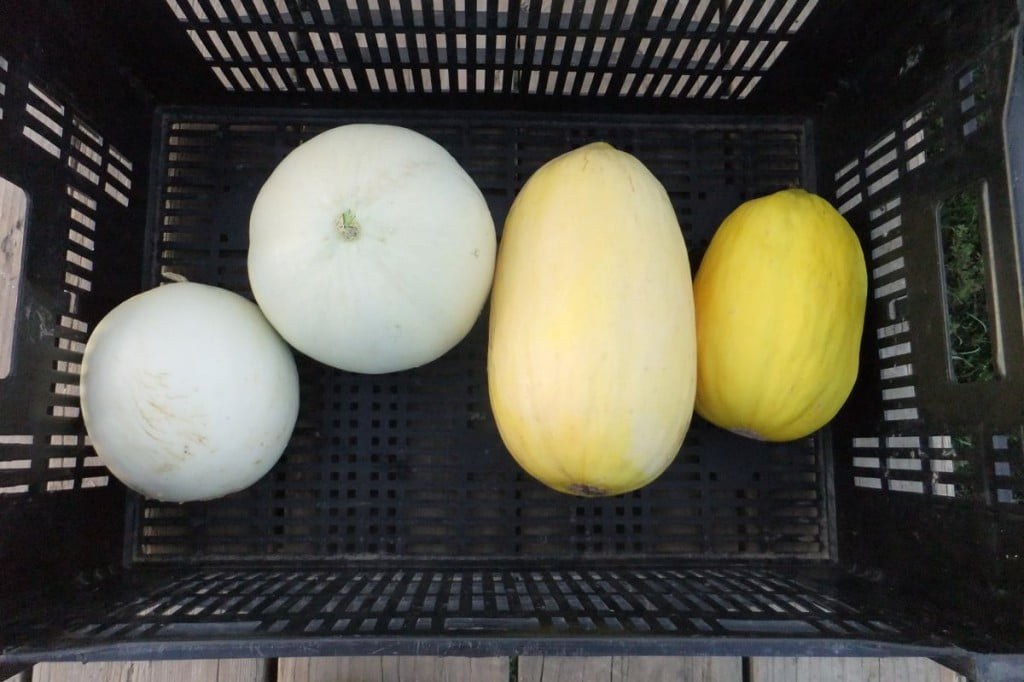Monthly Archives: August 2014
Water on, water off
- On: August 27, 2014
 0
0
We had too much water and too little water at the same time on Monday. A thunderstorm brought two inches of rain in about 45 minutes. That’s fast. Everyone worked indoors for an hour before heading out into the mud. Only one truck got mired! Meanwhile, a nearby lightning strike damaged the electronic control for our farmstead well. A broken well means we cannot wash produce. This is a big problem on a muddy day. We continued harvesting while our well expert Charlie Davis diagnosed the problem, gathered the parts, and got it fixed. By afternoon we could start washing. That was a full, busy day.
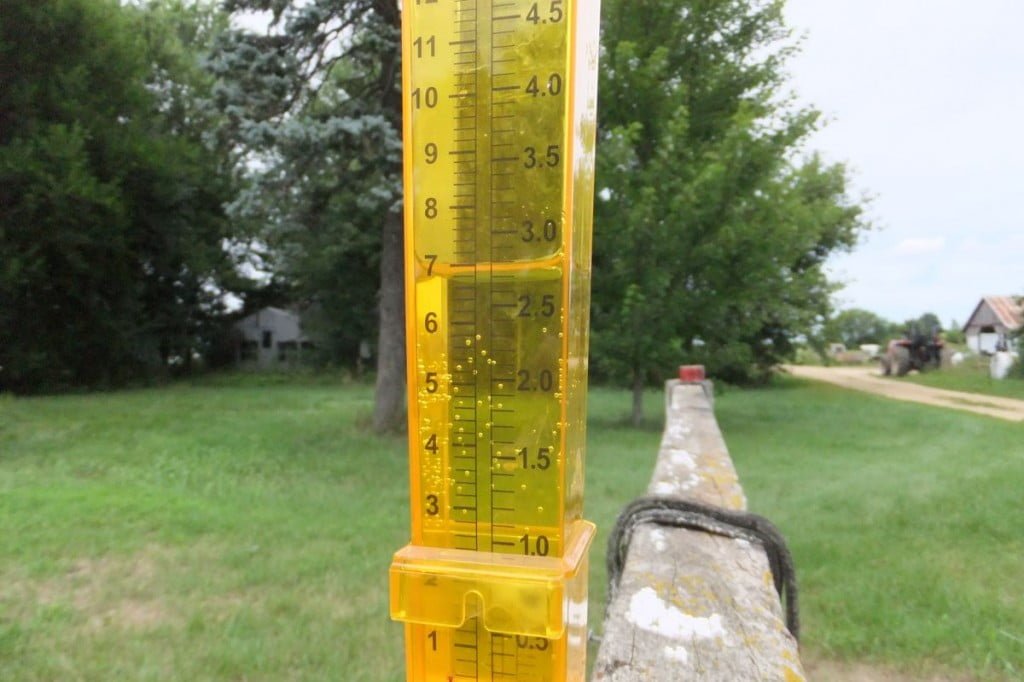
A total of 2.7 inches rain fell on Monday and Tuesday.
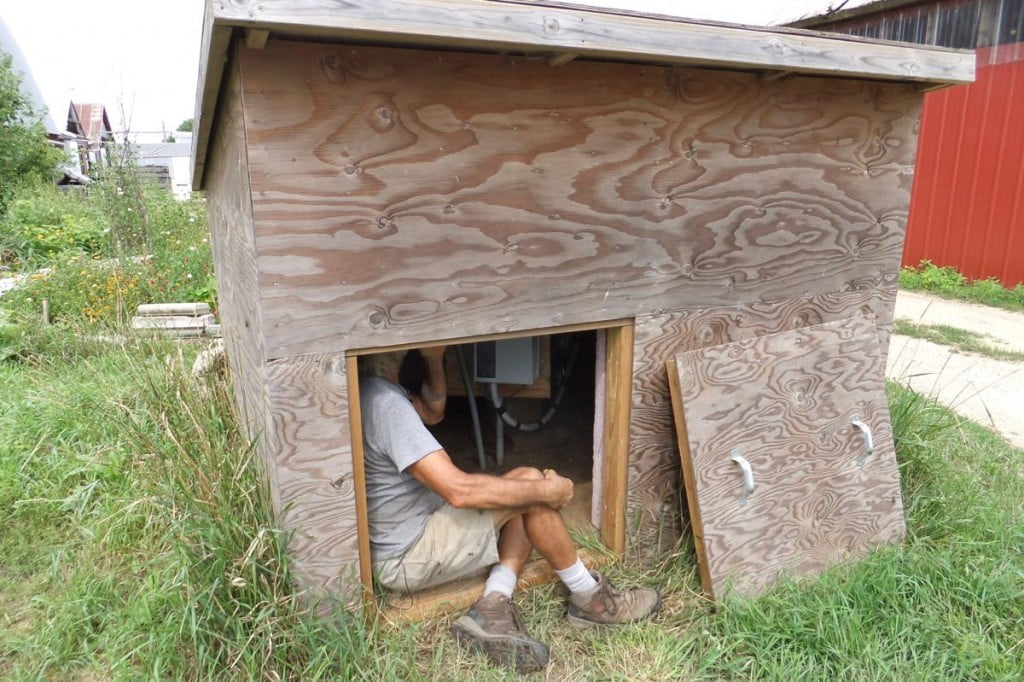
Steve checks electrical components in our well house.
Melon harvest is at its peak so we are sending two melons this week. Read below about the types. Enjoy them over the Labor Day holiday. This was a demanding week for Steve, as he picks and throws every watermelon. He estimates he picked 19,000 lb of watermelons and honeydew melons this week. Right now, he’s lying down on the floor to rest. A second crew, led by Michael and Billy, takes care of the muskmelons and crenshaws. The melon crews love this work. It’s fast-paced and productive, and they get to eat any dropped melons. Still warm from the sun, they are luscious.
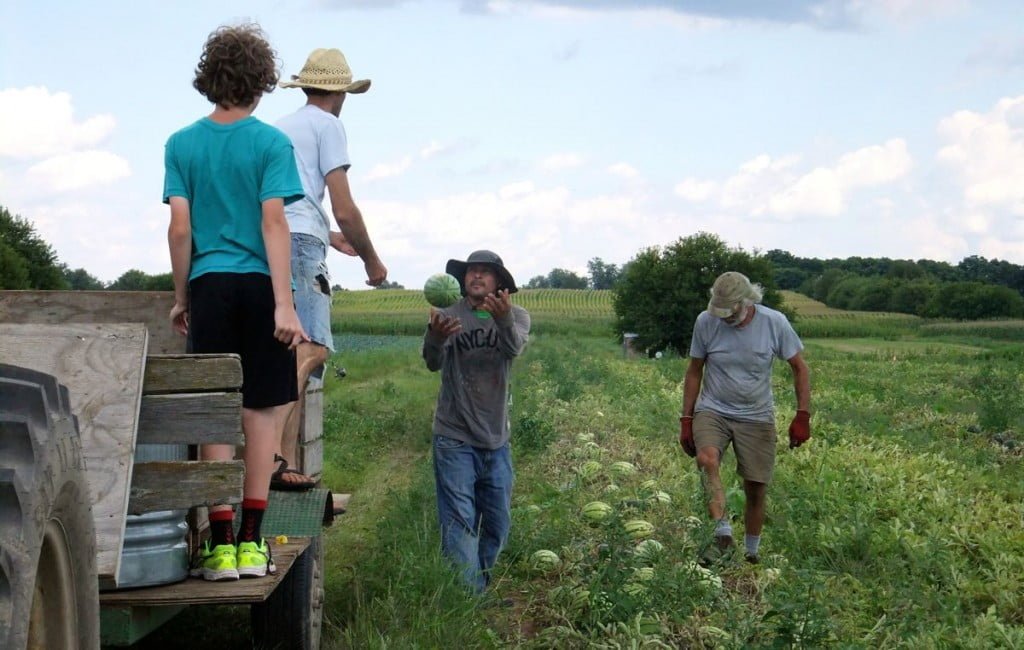
Melon harvest. From right, Steve chooses ripe melons then tosses them to Edgar, who tosses to Jon, who tosses to Ari, who washes the melons in a tank on the wagon.
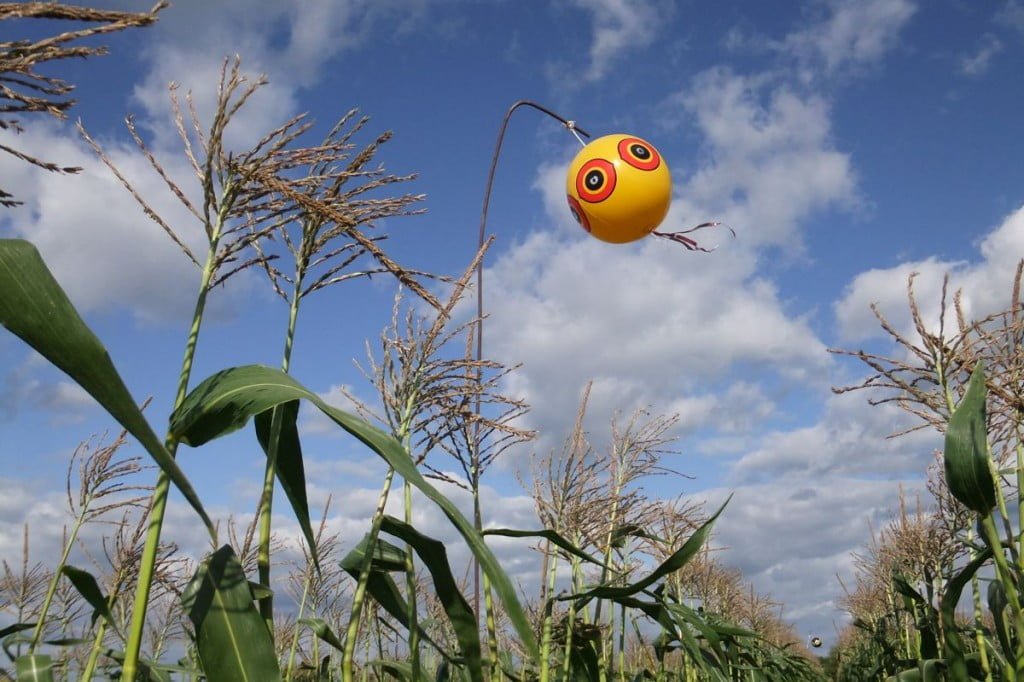
A modern scare crow protects the corn. The final sweet corn will be ready next week.
Veggie list (August 28/29, 2014, week #15, green EOW)
This is another full, heavy box. Carry your box from the bottom so it doesn’t break open. We’ll send everything on this list, as long as it fits in the box.
Orange watermelon
Crenshaw OR honeydew melon
Sweet corn, about 6 ears
Slicing & plum tomatoes, 3.75 – 4.0 lb
Colored bell pepper, 1 or 2
Orano pepper, 1 or 2
Yellow onions, 1 or 2
Cucumber (1 or 2) OR pickles
Lacinato OR Red Russian kale, 1 bunch
Dillweed, 1 stalk
Some sites will get eggplant. Some will get an heirloom tomato.
Next week’s box will probably contain red potatoes, sweet corn, leeks, tomatoes, peppers, poblano chiles, and more.
Tomatoes – All the tomatoes are in one bag. Here’s the breakdown: plum tomatoes, about 1 lb; slicing tomatoes, about 2.75 – 3 lb.
Yellow onions – We are sending yellow onions for the first time this year. These are pungent cooking onions, good for frying. We’ll switch back to sweet Walla Wallas over the next few weeks, so keep them segregated if you carry onions from week to week.
Cucumbers – There are a few oddly-shaped cucumbers this week. The cucumber season won’t last much longer, and we’re eager to send them while we have them. They are still delicious.
Melon ID (crenshaw vs honeydew), plus how to judge ripeness.
Orange watermelons – Round or slightly oblong, with the usual variegated watermelon ride. These are ripe. Eat soon.
Crenshaw melons – This oblong melon has a yellow exterior. The interior is pale orange with a soft, creamy texture, similar to muskmelon. These melons were ripe or nearly ripe when harvested but will improve after a day or two on your countertop. The end opposite the stem scar should be slightly soft when pressed. Refrigerate at this stage of ripeness.
Honeydew melons – This melon has an off-white rind, and a pale green interior. Most are round. We picked most of these melons slightly under-ripe to avoid the cracking that often ruins an otherwise good crop. Let your honeydew sit at room temperature for one to four days, until it softens slightly at the end opposite the stem. Feel your honeydew the day you bring it home, so you can recognize once it softens a bit. Honeydews without an attached stem will ripen sooner than those with a cut stem piece.
Out with the old, in with the new.
- On: August 20, 2014
 0
0
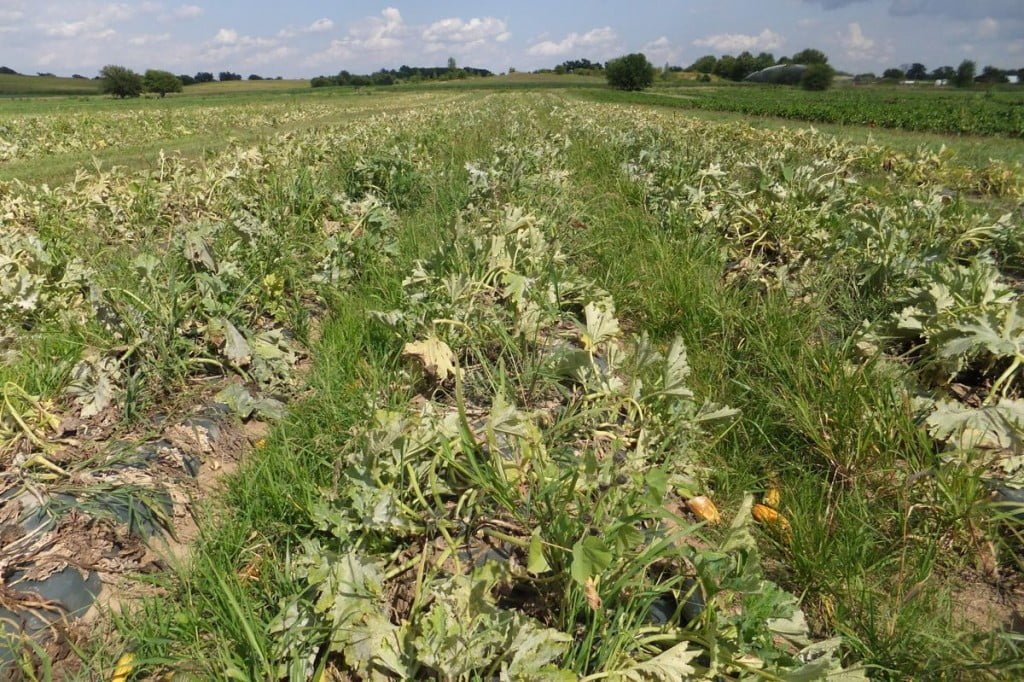
We recently retired our first zucchini and summer squash planting. The field was productive for two months but now the plants are exhausted and the field is overrun with weeds, bugs, diseases.
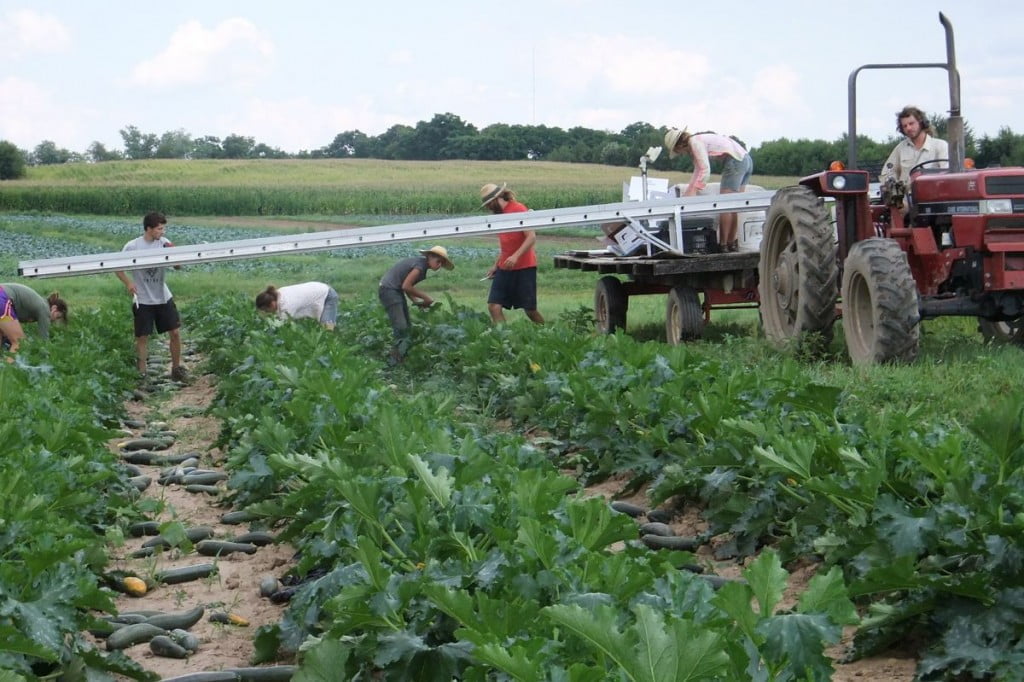
Everyone was relieved to move into planting #2. Doesn’t that look better? From left, Bri, Peter, Karen, Boi, and Clint place zucchini on the harvest belt conveyor which ferries it to the wagon. Kerry sorts and packs on the wagon. Michael drives the tractor. The squash on the ground are early, oddball ones that we cut to clean up the plants before the first harvest.
The harvest belt is one of the best investments we’ve ever made. It saves carrying squash out of the field, which saves everyone’s backs. It’s even more useful during heavy cabbage and winter squash harvests. Actually, it’s our two best investments, as this is our second harvest belt. It took ten years to wear out the first one.
Pepper feedback, please?
We’ve noticed internal problems on some of our bell peppers. We think the problem is isolated to one field, but we are not sure. We can’t open all the peppers to find out, but you can. Would you please tell us if you notice any internal problems on the peppers you receive this week, or last week? If you find problems, please send us an email titled “peppers!” with this information:
– your name,
– your pickup site,
– the week you received the pepper,
– what problem you found inside the pepper, and
– the type of pepper (red bell, yellow bell, orange bell, frying pepper, or Orano)
Thank you so much. We’d like to get this problem solved.
Please return all empty CSA boxes.
We are running low. Remember, we ask that you unpack your box and leave the empty at your pickup site each week. That keeps the boxes clean and prevents them from getting lost.
Veggie list and veggie notes (8/21/14, week #14, purple EOW)
We will send ingredients to make salsa: juicy tomatoes, cilantro, sweet onion, bell peppers and a few chiles of varied heat and flavor.
Slicing tomatoes, 5 lb
Cilantro, 1 bunch
Walla Walla onion, 1 or 2
Garlic, 1 bulb
Jalapeño (HOT), 1
‘Zavory’ habaneros (NOT HOT), 2
Bell peppers, mixed colors, probably 2
Oranos pepper, 1 or 2
Muskmelon
Romano beans OR globe eggplant OR Japanese eggplant
Cucumbers OR pickles OR Silver Slicer cukes, probably 2
Zucchini/summer squash, probably 2
Thai basil, 2 sprigs
Some members will receive one heirloom tomato. We will rotate the heirlooms among the sites as they are ready.
Next week’s box will probably contain watermelon, tomatoes, peppers, onions or leeks and more summer goodness. We’re on a roll with summer veggies!
Jalapeños (small, dark green, shiny) – The jalapeños are HOT, with estimated 5,000 Scoville units.
‘Zavory’ habaneros (small, pale green or red) – These habaneros are NOT HOT. Almost all the spice has been bred out of them, leaving a barely detectable trace of heat. Now we can all learn what habaneros actually taste like. The blazing heat always got in the way, as normal habaneros are about 200,000 Scoville units. You should still approach these chiles with caution. This is the first year we’ve grown ‘Zavory’, so we don’t know if there are off-types mixed in.
Garlic – The lovely garlic is the first harvest from our friend John Hendrickson of Stone Circle Farm.
Orano peppers (orange, tapered, sweet) – These sweet orange peppers look like frying peppers but behave more like bell peppers during cooking. They are excellent raw.
Muskmelon – Most are ripe and ready to eat. If you receive one that seems a bit green, let it ripen at room temperature for a day or two.
‘Thai Magic’ basil – This basil variety looks like Thai basil with it’s purple flowers but tastes much like Italian basil. We planted this variety because it is tolerant to a disease that’s circulating in Wisconsin this summer.
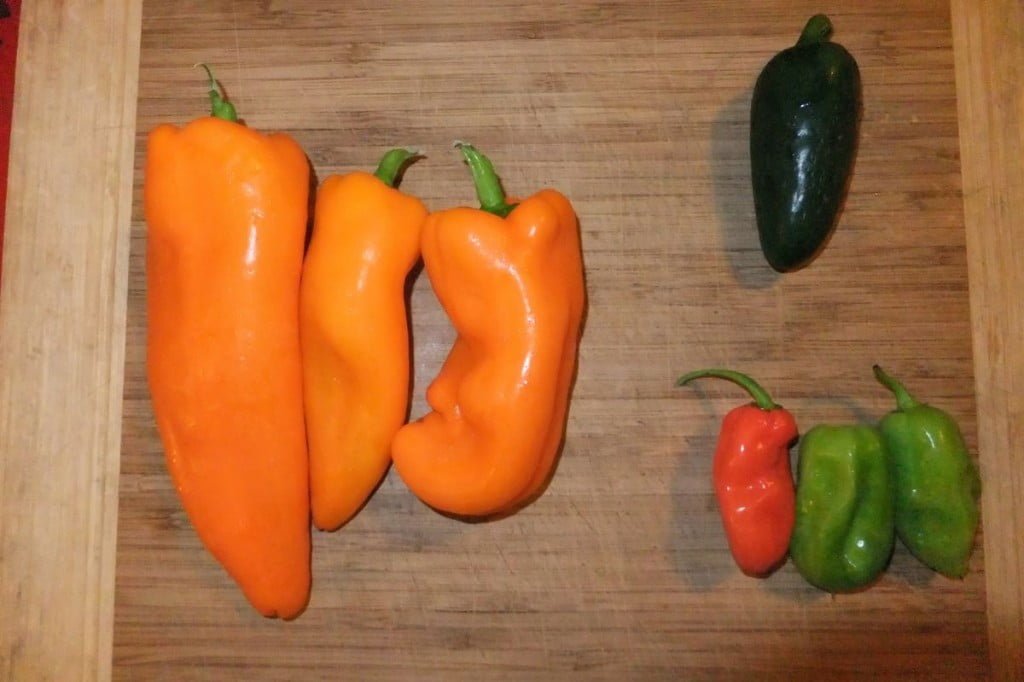
At left, Oronos (sweet); top right, jalapeño (hot); bottom right ‘Zavory’ habanero (not hot).
Our thoughts on a recent New York Times op-ed piece
- On: August 13, 2014
 0
0
Last night, our dinner conversation centered on an opinion piece in the New York Times titled “Don’t Let Your Children Grow Up To Be Farmers.” Author/farmer Bren Smith claims “The dirty secret of the food movement is that the much-celebrated small-scale farmer isn’t making a living.” It’s not true! We don’t claim that farming is easy but our farm (and others in Wisconsin) are proof that you can support a family on a small farm. Like many professions, the pay is low while you learn your skills. We lived frugally while starting and expanding our farm. We plowed our earnings back into the business for years but now we earn a middle-class income, like many of our customers.
What would we tell Bren Smith if we could talk to him?
– Don’t give up. There’s a long learning curve if you did not grow up farming. It will take time to accumulate the intuition, skills and tools that you need to be successful. Your land may need time and investment to develop too.
– Work on other farms. You will learn so much while earning a wage.
– Extend your season. It’s difficult to make a year’s income during a short growing season. Extend your work (and income) to a longer season with hoophouses or stored crops. Selling stored root crops through the winter is an important part of our farm’s stability.
– Understand that your income will fluctuate from year to year. Save during the good years.
– Farming (like every new business) requires investment. Your friends with salaried jobs do not have to invest financially in their work, but you do. That’s how it is. Be smart/cautious/frugal in your investments, including education.
– Start a food co-op. Co-ops become the hub for customers interested in local, good quality food.
– Band together with other farms in your area. Smith is correct when he writes that we need to “start our own organizations — as in generations past — and shape a vision of a new food economy that ensures that growing good food also means making a good living.” Our farmer coalition FairShare is an excellent example, in its efforts to foster the CSA marketplace in Wisconsin.
We think farming works in this region because of the consumers. That’s you, Tipi members. People in this area are willing to seek out, pay for, and eat food from small local farms. Each of those steps is a hurdle for the average customer. Whether through CSAs, farmers markets or local stores, people in this area support local farms and are rewarded with fresh, great-tasting food. Thank you all.
Beth & Steve
Sign up soon for Bike the Barns.
Bike the Barns will be held Sunday September 14. Learn more and register here. Hosted by FairShare farms, the annual ride is the primary fundraiser for our Partner Shares program. This year’s ride heads northeast from Madison, for either 45 or 60 miles. Don’t wait if you plan to join the ride. Registrations often fill by late August.
Upcoming sales of extra produce
We hope to have extra basil and extra slicing tomatoes to sell during the next month. Watch for emails from me. It will be a few more weeks before we have plum tomatoes to sell.
When should you refrigerate tomatoes?
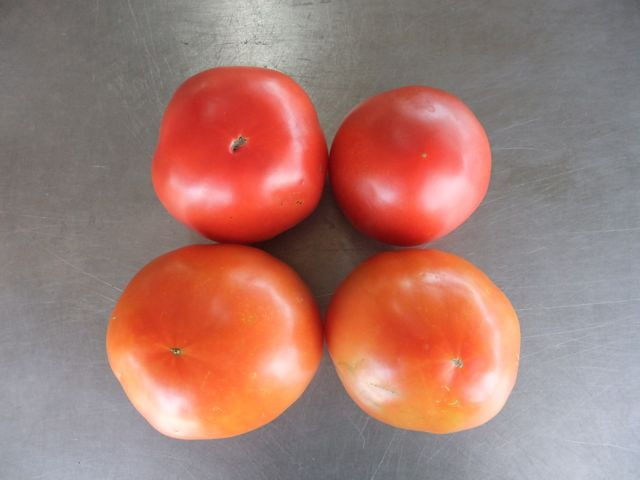
Ripe tomatoes (top) and less-ripe tomatoes (bottom).
As usual, we have packed a mix of ripe and less-ripe tomatoes so you can stretch them through the week. The top two tomatoes in the photo are ready to eat. The bottom tomatoes need to ripen at room temperature for a few days. Put on your counter or keep in a brown paper bag.
Tomatoes retain their best flavor and texture when stored at room temperature, no lower than 55oF. However, you should refrigerate your tomatoes if they are fully ripe and you don’t expect to eat them right away. It is better to sacrifice a little flavor and texture than lose your tomatoes to rot. Also, fully-ripe tomatoes are less sensitive to chilling injury.
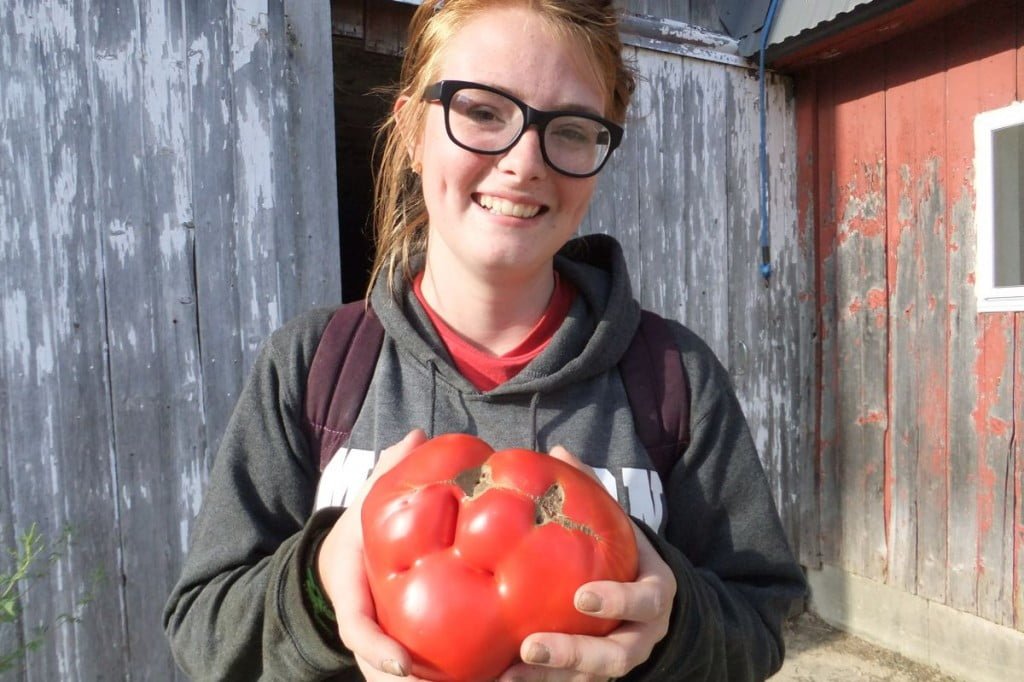
Farmhand Caitlyn holds today’s most celebrated tomato. It’s the largest tomato we picked and it looks just like an “old grandmother’s face.”
#2 Grade Red Bell Peppers
I write about pepper grading every year. Returning members can say “yeah, yeah” and skip ahead. New members, please read.
Many of the red bell peppers we send in the CSA boxes will be our #2 grade. We do this to avoid waste and to deliver good value to our CSA members. The #2 grade peppers are excellent eating quality, but are not quite pretty enough to sell to stores. As a result, we place a much lower value on these peppers. This allows us to provide generous amounts of red bell peppers over the course of the season, about three times the amount we could provide if we only gave #1 grade. We feel this is a good exchange, even if it means you occasionally open a pepper and find that it needs trimming. Here are the reasons that peppers are downgraded from #1 grade to #2 grade:
1. They may have a minor blemish, or
2. They may have minor insect damage, or
3. They may be very ripe and beginning to wrinkle. (These are especially sweet and delicious as they are fully ripe. These cannot be sold to stores because their shelf life is short. The texture is less crisp than a #1 grade pepper, but the flavor more than makes up for it.)
4. They might be partially red and partially green.
5. Others are just too small.
The eating quality is fine (or excellent) for all these #2 peppers. We throw away all peppers that we suspect have rot inside (although one may occasionally slip through in either #1 or #2 grade.) Today’s peppers are #2 grade.
Veggie list and veggie notes
Be prepared, this box is very full and very heavy. We will send everything on this list, as long as we can fit it in the box.
Sweet corn, about 10 ears
Yellow watermelon OR orange watermelon OR muskmelon
Red slicing tomatoes, 5 lb, mixed ripeness
Bell peppers (red, yellow, or orange), 1 or 2
Romano beans, 1 lb
Carrots, 2 lb
Cucumbers (1 or 2) OR pickles
Walla Walla onion, 1 or 2
Flat parsley, 1 bunch
Next week’s box will probably contain melon, tomatoes, peppers, cilantro and more summer goodness.
Sweet corn – This is a new variety, picked at its peak. It’s more creamy and less sugary than the variety we sent last week. Steve says this variety achieves the ‘old-fashioned’ flavor of the varieties he grew years ago.
Melons – Everyone will get a muskmelon (netted skin, orange flesh) or a yellow watermelon (sweet, yellow interior) or an orange watermelon (pale orange interior, sweet, tender).
Pretty edges
- On: August 06, 2014
 0
0
There are some lovely places on the lands surrounding our farm. Let’s take a look.
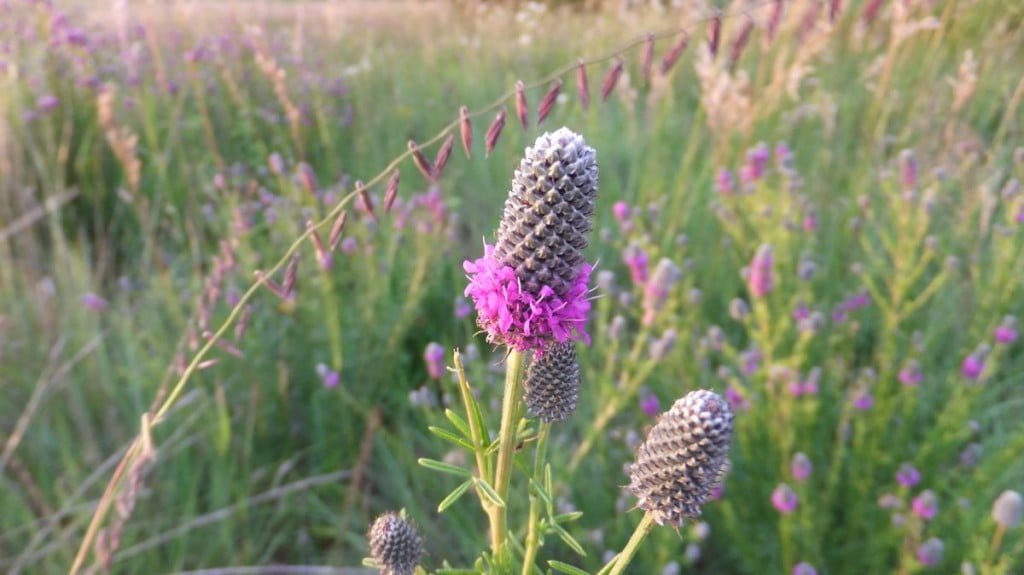
Purple prairie clover flowers, with dangling side-oats grama in the background.
Our neighbors planted a prairie strip along the border between our farms about five years ago. They said “We thought you wouldn’t mind.” They know our farm is certified organic. At 150 feet in width, the prairie strip is a substantial buffer for our crops. It’s a fascinating place to visit, even in winter.
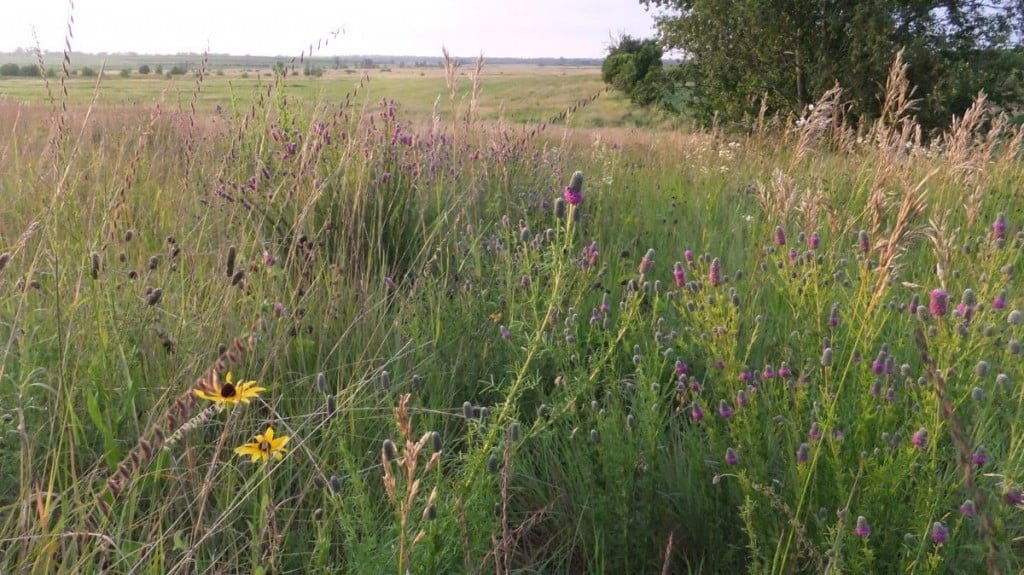
The prairie strip overlooks hunting grounds managed by the Wisconsin Department of Natural Resources (DNR).
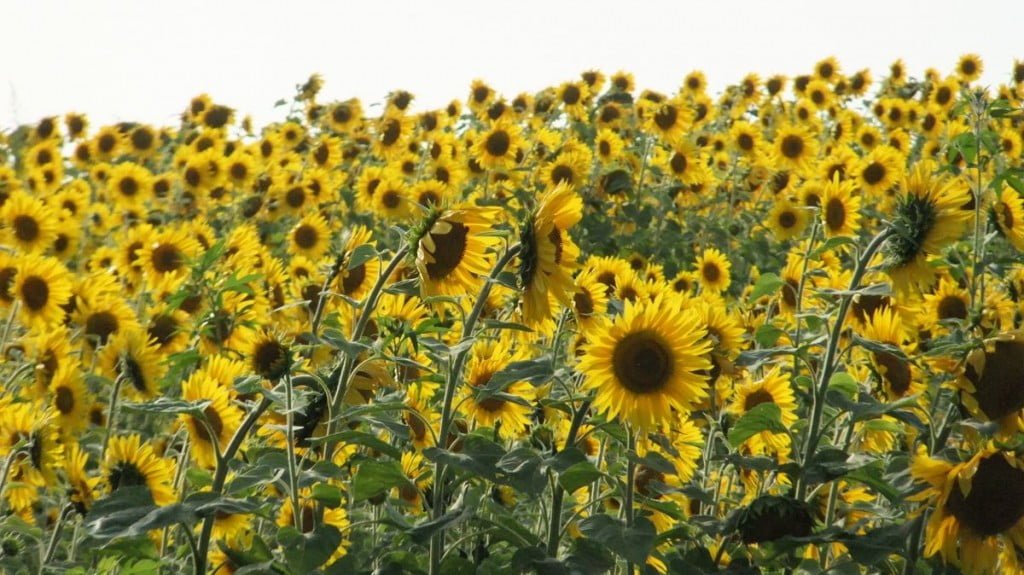
The DNR contracts with local farmers to grow sunflowers on some of those public lands. The sunflowers won’t be harvested. Instead, they will be left in the field to provide food for wildlife in fall and winter. See the DNR website for an article about annual crops that are useful for feeding wildlife. The article states that “sunflower seeds won’t last into the winter … as they are heartily feasted upon by ravenous songbirds during fall migrations.”
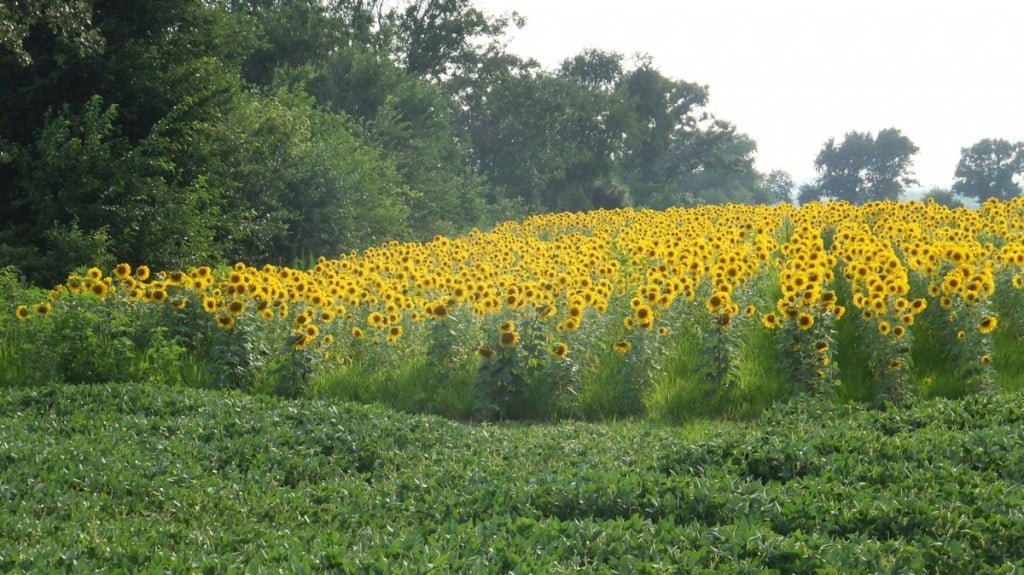
The sunflowers are so vivid at full bloom.
I’m back from vacation …
and ready to take emails again. Thank you, everyone, for limiting your emails while the kids and I were away. Steve is very busy while we are gone. It’s feels crazy to leave the farm for ten days at the height of the season. However, both our families live on the east coast. This summer trip allows our children to see their relatives more than once per year. I could not leave for that long with help from Steve and Kerry, my right-hand-woman in running the CSA. I appreciate their help so much.
Veggie List and Veggie Notes (8/7/14, week#12, purple EOW)
Red watermelon
Red slicing tomatoes, 2 to 2.5 lb
Red bell OR frying peppers, 2 or 3
Sweet corn, about 3 ears
Green beans, 1/2 lb
Carrots, 2 lb
Collards, 1 bunch
‘Summercrisp’ lettuce
White onion, 1
Red onion, 1
Cucumbers, about 2
Basil, 1 sprig
As long as we can fit them in the box, we will also send …
Zucchini & summer squash, 2 pieces
Next week, we hope to send melon, tomatoes, peppers, carrots, sweet corn, beans, onions, cucumbers, an herb and more.
Sweet corn – Much of this week’s corn is from a new planting, and the ears are on the young side. It won’t need much cooking. It was an exacting harvest and there may be some underripe ears mixed in. Our apologies in advance if you get one of them.
Collard greens – Summer greens are tougher than greens harvested during cool spring weather. Cook these longer than the spring collards.
Onions – We’ve sent a yellow Walla Walla onion for raw eating, plus a red onion for raw or cooked dishes. The red onion should fry nicely.
Cucumbers – We have a small planting of a new, white cucumber called ‘Silver Slicer.’ It is interesting and tasty. We don’t have enough for everyone this week, but we will try to distribute them to all the sites over the next few weeks.
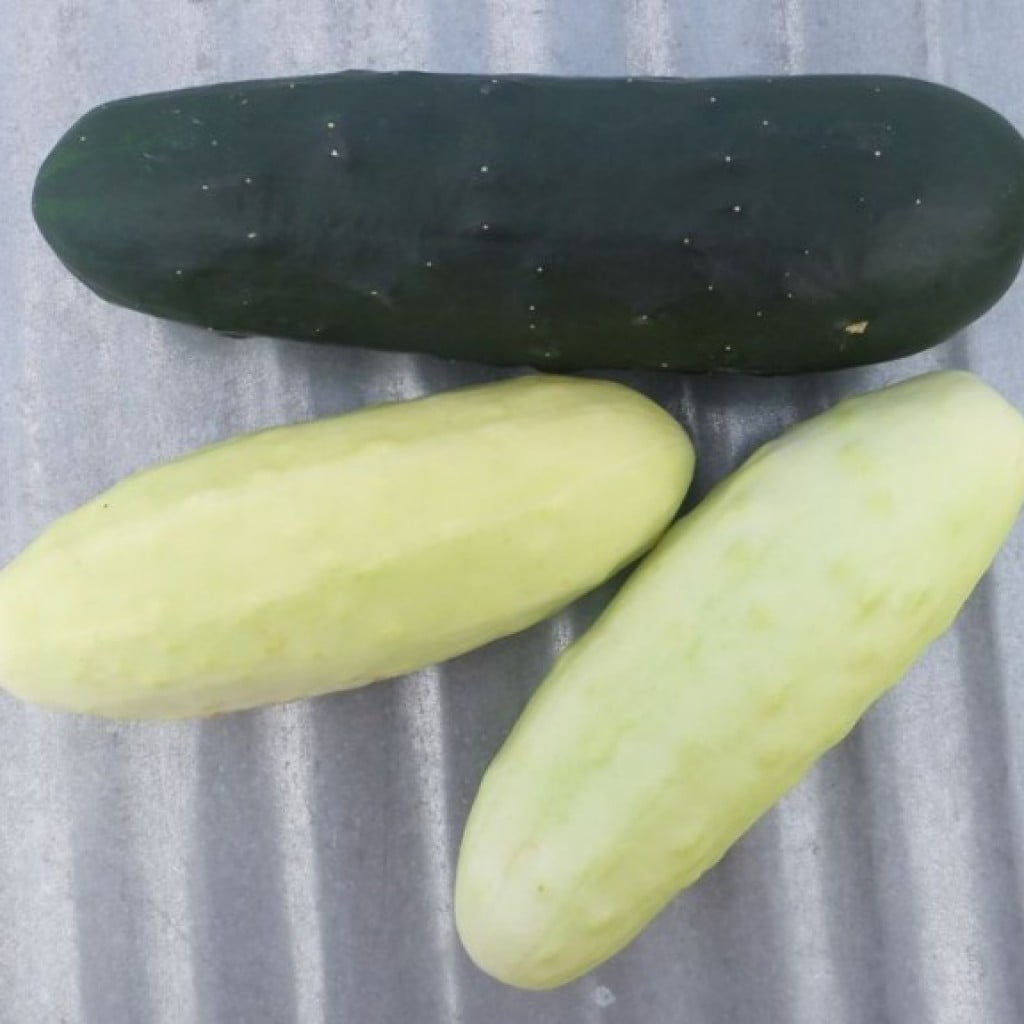
One traditional green cucumber and two ‘Silver Slicer’ cucumbers.
Veggie List (7/31/14, week #11, green EOW)
- On: August 05, 2014
 0
0
Sweet corn , 8 ears
Muskmelon OR Yellow Doll watermelon
Green beans, 1.5 lb
Cherry tomatoes, 1 pint
Red leaf lettuce
White onion, 1 large (1+ lb)
Green bell pepper, 1 large
Zucchini/summer squash, 2 lb
Cucumbers, 2
Basil
Eggplant OR broccoli OR red slicing tomatoes

